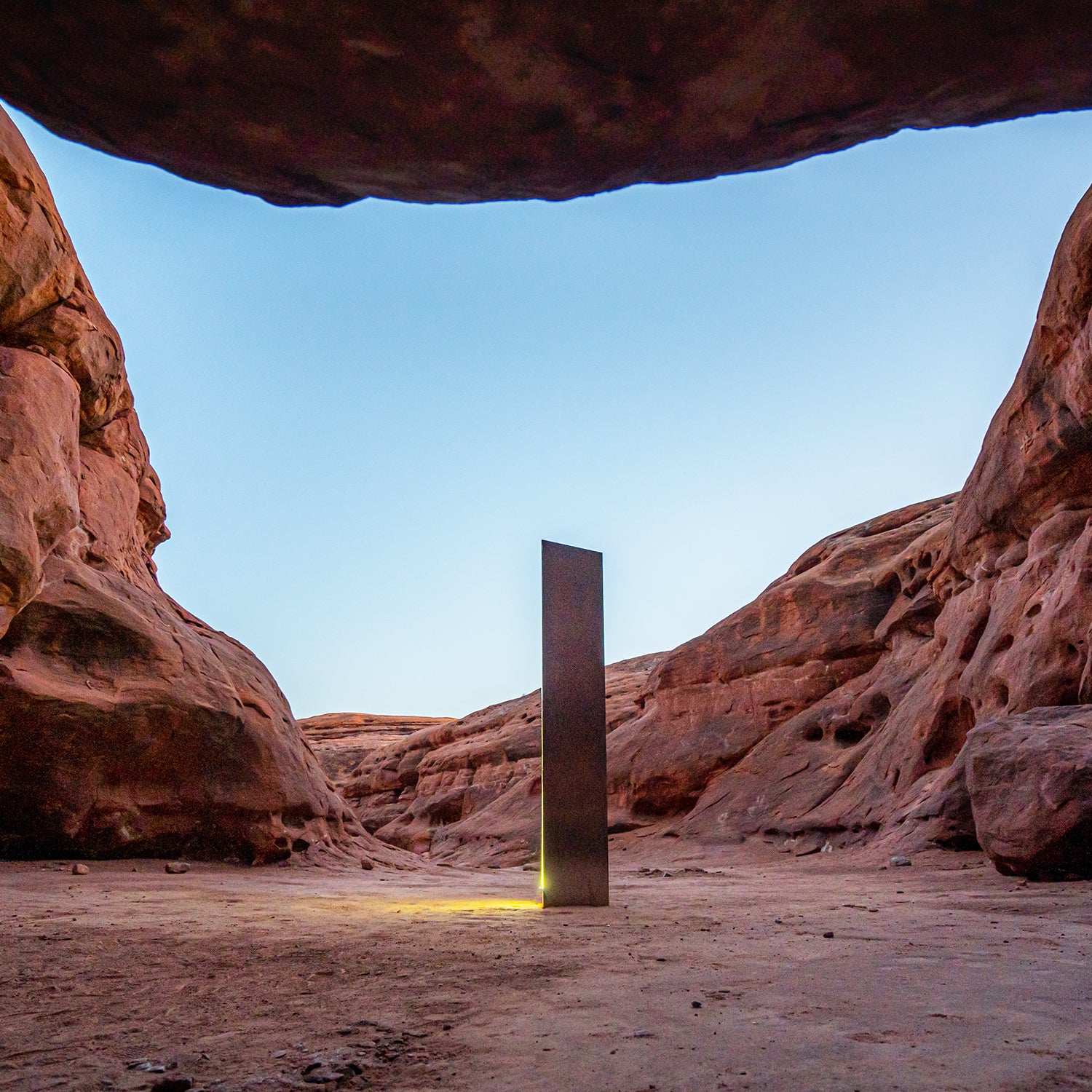Must have been a slow news week, or perhaps reporters beaten down by the virus and the election just needed some holiday mirth, because on November 23, when some��Utah sheep counters announced their discovery of the weird shaft of steel in a red-rock canyon near Moab, the media went nuts. The so-called Utah monolith was covered by , , and ; to date,��The��New York Times ����on��it, with international art players speculating about the identity of the sculptor, who remains unknown. Stephen Colbert dedicated his “mono-logue” to the object.
By the morning of November 24,��photographers, Instagram self-promoters,��and other yahoos��had figured out the undisclosed location and were descending in droves, publishing the coordinates and directions online. A crew of reality-TV dudes with beards and muscles landed in a helicopter, filmed themselves measuring the thing, used phones to record latitude and compass direction, then produced a fiberglass stepladder and snapped selfies perched on top. The Bureau of Land Management posted pictures��of dozens of cars and RVs sleuthing the zone, fresh tire tracks over fragile soils, toilet paper fluttering in the breeze. The Insta-famous slab of steel was poised to replace the void left by the removal of the Into the Wild school bus in Alaska and take the mantle of world’s dumbest backcountry shrine.
It was a short run. After dark on Friday��night, November 27, four men with strong headlamps and a wobbly wheelbarrow shoved the tower unceremoniously to the dirt, wrenched it from its foundation, and hauled it away, admonishing onlookers:��“This is why you don’t leave trash in the desert.” Two Moab slackliners, Andy Lewis and Sylvan Christiansen, took credit on Facebook for the removal.
As reporters reveled largely in the jolly questions of who done it and who undone it, internet basements simmered with scolding. While many loved the elegant art piece, made all the more sublime by the artist’s invisibility, others condemned the incursion of any man-made object in pristine desert. Next, as some attacked Lewis and Christiansen for undemocratic art removal, others lauded them for taking decisive action to shut down a circus.
So��who’s in the right? The artist or the art destroyers? Or both?��
First, I think we can establish that this slab of steel is not “trash.” It’s a gorgeous piece, thoughtfully composed in-line��with a dry waterfall in a shallow amphitheater. But what makes it great is not the structure so much as the process. The artist installed it in secret, .��They��took no credit, held no gala opening, posted nothing online. It feels like the purest artistic vision: a perfectly executed work without any of the acclaim or ego or money that drives the rarified gallery world. The piece makes me think (well, it made my wife think first, and then she suggested that I think) of coyotes and ravens examining their reflections. It makes me consider the awe of solitude, and later, after its discovery, how easily that awe is corrupted.
One of the media obsessions has been determining the identity of the artist. Several were named. Which raises the question: If��this were the work of a famous artist, would that make it “important”? Would that��make it more or less likely to require removal? I tend to believe that an artist capable of fabricating and installing the piece in such a remote place was also capable of understanding that its power lay in its anonymous mystery.
So instead of thinking of it as vandalism or a prank, let’s put it in the category of land art,��whose rich history in the West includes Robert Smithson’s in Utah,��James Turrell’s in Arizona, and��Michael Heizer’s in Nevada. The jetty was legally installed��in 1970 and has become a beloved destination, but I wonder if it would have been lambasted in the age of social media. The latter two are on private land, not open to the public, and have therefore largely escaped environmental criticism. The monolith also belongs to a second category: guerilla art, which is to say unpermitted public art serving��a higher purpose; it makes��make us think, laugh, admire, and, not least of all, question the purpose of art. I’m thinking of the ,��which��installed speakers in a forest that played the sound of a tree falling, and of Earth First down the front of Glen Canyon Dam.
If we can establish the fact that it is art, and good art (which I know we can never agree on),��then we can tackle the question of land ethics. After all, it might be fine for one of us to drive into the desert, gather all the downed ancient juniper, and make a roaring bonfire. But when dozens or hundreds do it, the desert loses its soul��and��becomes a tire-tracked fire pit.��I agree that if everyone decided to erect a metal masterpiece on inaccessible public lands, we’d have a problem. And although copycat versions��have already been found in ��and , it seems that the costs and logistics alone will prevent a major outbreak. If we’re going to be purists about pristine nature, then we’d do better to focus our ire on things like roads, mines, and, for that matter, national parks, which alter the landscape much more dramatically than this monolith. As for those intent on condemning any art placed on public lands, the biggest fish to fry is Mount Rushmore, carved into sacred Lakota��lands that were ceded by treaty to the tribe, then stolen by the United States.
Now what about the ethics of removing the monolith? The San Juan County sheriff declined to launch an investigation. The sculpture was there illegally to begin with, and once it was taken, who was the victim? The artist? The land? The public? One could argue that the removers had no right to remove the object. Who appointed them the purveyors of eco-ethics? And there’s something chilling about the act, when we remember members of the Taliban dynamiting ancient Buddhist towers, taking it upon themselves to determine what is decent.
But I don’t see the removal as a judgment of the art itself,��its merits, or even its right to exist. As Christiansen wrote in a Facebook comment on one of , it was a means to stop the caravan of lookie-loos: “The ethical failures of the artist for the 24��[inch]��equilateral gouge in the sandstone from the erecting of the Utah Monolith, was not even close to the damage caused by the internet sensationalism and subsequent reaction from the world.”
They took the kind of quick, decisive action that the BLM (for good reason) is incapable of. I may not want these dirtbags (I mean that with the utmost respect) elected to Congress, or working as dogcatchers, but this specific action appears ethically sound.
So��are there any ethical lapses in the one-week life span of the silver tower? The actions of the internet sleuths and YouTubers, while kind of fun to watch, were self-serving and irresponsible. The purpose of posting the��videos, of course, is to gain clicks and advertising money. While the artist did all the work and took no credit, these bros are trying to capitalize on the art without doing the work. I don’t see an ethical defense of posting the location and directions to a place that will surely be overrun. The man who claimed to be the first to find the site : “I had it alone to myself for about 10 minutes��in the morning before people started showing up but overall not too crowded��you all want to make the journey.” This statement distills social media’s toxic effect on wilderness: I got my minutes of glory, then it got trampled, but you should go, too, and don’t forget to hit the subscribe button.
The beauty of the silver tower was its solitude. In order to be sublime, it had to be alone. And as soon as humans “found” it, it lost its magic. Isn’t this the way of all arches, waterfalls, and slot canyons?��So perfect in their anonymity, so wrecked by a race that can’t stand to leave beauty alone. The desolate canyon will be just as gorgeous without the obelisk, and now those who want to leave the beaten track can enjoy it, and thousands just like it, without battling the blitz of the #explorers. The quick flash of metal will be outlasted by the timeless erosion of the earth, the trickle of red sand finding its way to the river,��to the sea.


